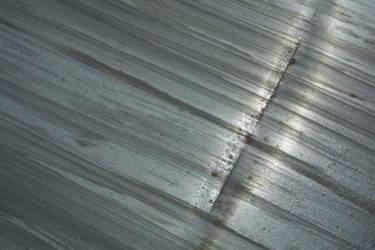Things You'll Need
Dish soap
Scrub brush
Towel
Fine grit sandpaper
Sanding block
Metal file
Hammer (optional)
Steel wool
Patina solution
Paint brushes

The pristine shine of new sheet metal can sometimes appear to lack character and style. To add vintage appeal to various types of metalwork, you can distress it using fine abrasives like sandpaper and steel wool. Depending on the desired effect, a patina can also be applied to the surface of the metal.
Step 1
Wash the metal piece thoroughly using dish soap and a scrub brush. This will remove any metal fragments or debris which may gouge the surface too deeply during the distressing process.
Video of the Day
Step 2
Attach a piece of fine grit sandpaper to your sanding block. For greater effect, use a piece of medium or coarse grit paper.
Step 3
Rub the entire metal piece with your sanding block, paying special attention to corners and edges. For an even look, use a firm back an forth motion. For a more erratic, random look, use a circular or diagonal motion.
Step 4
Smooth sharp corners and scuff up the surface of the piece with a metal file. If desired, pound the metal piece with a hammer to create the look of rugged use.
Step 5
Finish by rubbing the metal thoroughly with steel wool pads. Pads are available in a number of different coarseness ratings, so choose the one that best suits your desired results.
Step 6
Wash the metal piece under a cool stream of water. Dry it completely with a towel.
Step 7
Apply a coat of patina solution to the piece with a paintbrush. Patina is available at most craft stores in a variety of colors, including black, dark brown, amber and deep red. For a darker tarnish, spread on the patina thickly. For a lighter tarnish, spread it thinly over the entire piece.
Step 8
Allow the patina to dry for the time suggested on the container. If desired, you can partially sand the patina off for an even more distressed look.
Tip
Distressed metal looks good on objects that are intentionally meant to have a dated feel, from old bicycles to wrought-iron fences to classic art sculptures.
Instead of a metal file, use a belt sander to smooth out rough edges.
Warning
Use caution when handling your metal piece, especially if it is freshly cut or engraved.
Video of the Day